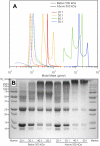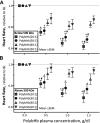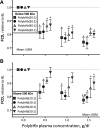Effects of the molecular mass of tense-state polymerized bovine hemoglobin on blood pressure and vasoconstriction
- PMID: 19745190
- PMCID: PMC2777796
- DOI: 10.1152/japplphysiol.00622.2009
Effects of the molecular mass of tense-state polymerized bovine hemoglobin on blood pressure and vasoconstriction
Abstract
Despite recent advances in the design of hemoglobin (Hb)-based oxygen carriers (HBOCs), vasoconstriction, presumably caused by nitric oxide (NO) scavenging, vessel wall hyperoxygenation, and/or extravasation, has been identified as the principal road block hampering commercial development of HBOCs. This study was designed to analyze systemic and microvascular responses to the molecular mass and plasma concentration of tense (T)-state polymerized bovine Hb (PolybHb) solutions. Experiments were performed using the hamster window chamber model subjected to successive hypervolemic infusions of T-state PolybHb solutions. PolybHb plasma concentrations were evaluated, namely, 0.5, 1.0 and 1.5 g/dl, respectively. Infusion of PolybHb solutions with molecular mass >500 kDa elicited hypertension and vasoconstriction proportional to the plasma concentration and inversely proportional to the PolybHb cross-link density. However, two high-molecular mass PolybHb solutions, PolybHb(40:1)(high) PolybHb(50:1)(high), did not elicit vasoconstriction at all concentrations studied, whereas PolybHb(50:1)(high) only elicited moderate hypertension at the highest concentration studied. In contrast, infusion of PolybHb solutions with molecular mass <500 kDa elicited significant hypertension and vasoconstriction compared with PolybHb solutions with molecular mass >500 kDa that was proportional to the plasma concentration and inversely proportional to the PolybHb cross-link density. We present promising results for highly cross-linked T-state PolybHb solutions with molecular mass >500 kDa [PolybHb(40:1)(high) PolybHb(50:1)(high)], which supports the concept that HBOC size/molecular mass influences its proximity to the vascular endothelium and molecular diffusivity. The hemodynamics of HBOC within the plasma layer surrounding the abluminal side endothelium regulates NO production and consumption, vessel oxygen flux, and extravasation. Although mechanistically attractive, neither of these hypotheses can be directly tested in vivo and will require further investigation.
Figures







References
-
- Alayash AI. Oxygen therapeutics: can we tame haemoglobin? Nat Rev Drug Discov 3: 152–159, 2004. - PubMed
-
- Atha DH, Riggs A. Tetramer-dimer dissociation in hemoglobin and the Bohr effect. J Biol Chem 251: 5537–5543, 1976. - PubMed
-
- Bouwer ST, Hoofd L, Kreuzer F. Diffusion coefficients of oxygen and hemoglobin measured by facilitated oxygen diffusion through hemoglobin solutions. Biochim Biophys Acta 1338: 127–136, 1997. - PubMed
-
- Bradford MM. A rapid and sensitive method for the quantitation of microgram quantities of protein utilizing the principle of protein-dye binding. Anal Biochem 72: 248–254, 1976. - PubMed
-
- Cabrales P, Tsai AG, Frangos JA, Briceno JC, Intaglietta M. Oxygen delivery and consumption in the microcirculation after extreme hemodilution with perfluorocarbons. Am J Physiol Heart Circ Physiol 287: H320–H330, 2004. - PubMed
Publication types
MeSH terms
Substances
Grants and funding
LinkOut - more resources
Full Text Sources
Other Literature Sources

